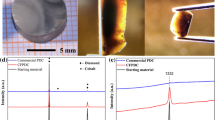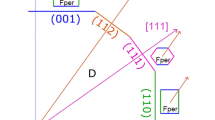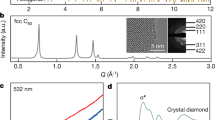Abstract
IN the course of X-ray diffraction work on synthetic diamonds1, many specimens were found to contain polycrystalline inclusions. A sample of coesite2 made at the National Physical Laboratory, and kindly given to us by Sir Gordon Sutherland, has enabled us to identify it as the most prominent of the inclusions encountered (see, for example, ref. 1, Plate X, Figs. 1, 2).
This is a preview of subscription content, access via your institution
Access options
Subscribe to this journal
Receive 51 print issues and online access
$199.00 per year
only $3.90 per issue
Buy this article
- Purchase on SpringerLink
- Instant access to full article PDF
Prices may be subject to local taxes which are calculated during checkout
Similar content being viewed by others
References
Lonsdale, K., Milledge, H. J., and Nave, E., Mineral. Mag., 32, 185 (1959).
Zoltai, T., and Buerger, M. J., Z. Kristallog., 111, 2 (1959).
Chao, E. C. T., Shoemaker, E. M., and Madsen, B. M., Science, 132, 220 (1960).
Lipschutz, M. E., and Anders, E., Report EFINS-60-32 (University of Chicago, 1960).
de Carli, P. S., and Jamieson, J. C., Tech. Rep. 001–61, Poulter Laboratories, Stanford Research Institute, Calif., U.S.A.
Grenville-Wells, H. J., Mineral. Mag., 29, 803 (1952).
Williams, A. F., The Genesis of the Diamond, 2, 423 (1932).
Author information
Authors and Affiliations
Rights and permissions
About this article
Cite this article
MILLEDGE, H. Coesite as an Inclusion in G.E.C. Synthetic Diamonds. Nature 190, 1181 (1961). https://doi.org/10.1038/1901181a0
Issue date:
DOI: https://doi.org/10.1038/1901181a0



